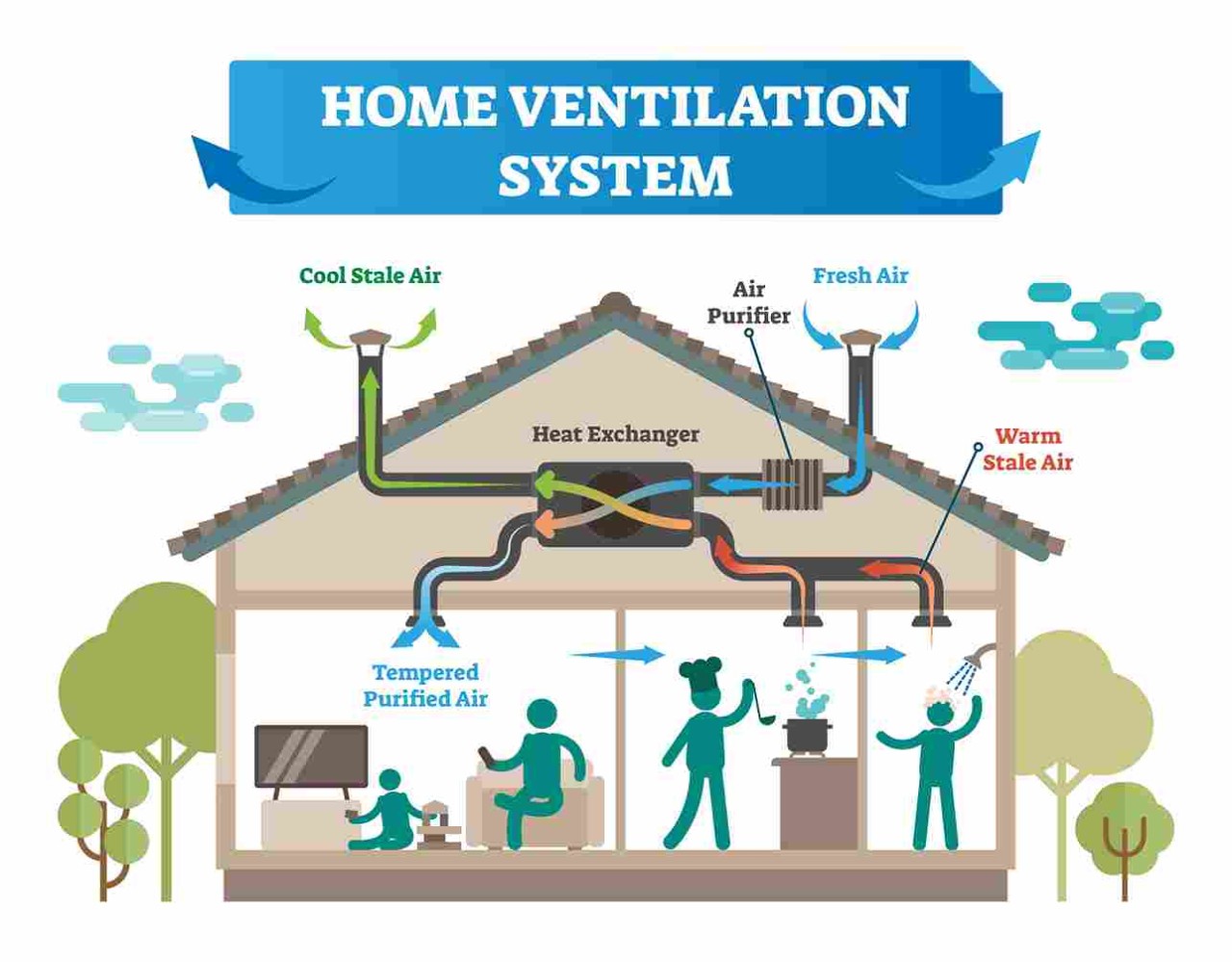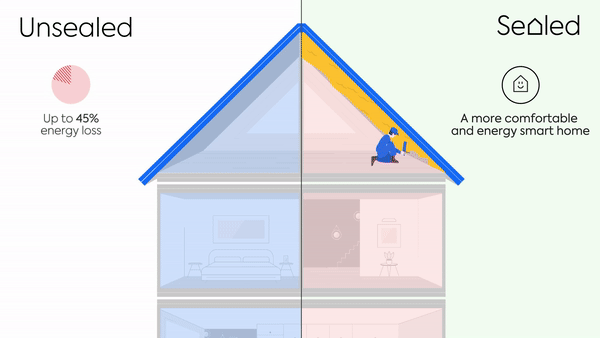Home Ventilation Melbourne Strategies to Combat Indoor Air Pollution
Wiki Article
Discovering Cutting-edge Solutions for Optimum Home Air Flow Solutions
Home air flow plays a vital function in keeping health and wellness and convenience within living rooms. With developments in modern technology, innovative services are arising to maximize these systems. Smart ventilation, energy healing ventilators, and progressed filtration are reshaping just how air quality is managed - Home Ventilation Melbourne. Nevertheless, the assimilation of these innovations questions concerning their efficiency and flexibility in varied home atmospheres. What ramifications do these growths hold for future living requirements?The Relevance of Home Air Flow for Health and Comfort
Although commonly overlooked, home air flow plays an essential role in keeping both health and comfort within household areas. Adequate ventilation is crucial for the circulation of fresh air, which assists to thin down indoor contaminants such as unpredictable natural compounds, irritants, and smells. Without correct air flow, these pollutants can gather, bring about respiratory system concerns and other health problems. On top of that, efficient ventilation adds to controling humidity degrees, protecting against mold and mildew growth and structural damages. By guaranteeing a balanced exchange of air, residents can appreciate an extra pleasurable indoor setting, improving general health. Additionally, appropriate ventilation can boost energy performance by lowering the requirement for excessive home heating or cooling, inevitably leading to reduced utility expenses and a more lasting home.Smart Air Flow Systems: Harnessing Innovation for Performance
Smart ventilation systems represent a considerable advancement in home air administration, leveraging IoT integration for improved control. These systems not just promote energy performance but also use remote monitoring abilities, allowing individuals to maximize their indoor atmospheres perfectly. By utilizing modern technology, homeowners can achieve improved air quality while decreasing energy usage.IoT Combination Benefits
Exactly how can IoT combination transform conventional ventilation systems into extremely effective wise services? By integrating Web of Things (IoT) technology, ventilation systems can achieve real-time monitoring and control, boosting their functional effectiveness. Sensors placed throughout a home collect information on air temperature level, top quality, and humidity, enabling for automated changes based upon existing conditions. This immediate responsiveness results in boosted interior air quality and convenience degrees. On top of that, IoT-enabled systems can communicate with various other smart home gadgets, developing a natural environment that optimizes power usage. Customers can additionally access and handle their ventilation systems from another location using smartphones, offering comfort and raised control. Overall, IoT integration represents a considerable advancement, bringing intelligence and flexibility to standard ventilation techniques.Energy Performance Features
As power efficiency comes to be an important focus in contemporary home design, progressed ventilation systems supply ingenious attributes that significantly lower energy intake. These smart ventilation systems make use of sensors to keep track of interior air quality, moisture, and temperature level degrees, immediately adjusting air flow to keep suitable problems. By employing power recuperation ventilators (ERVs), they reuse and catch power from outward bound air, lessening home heating and cooling down needs. Variable rate followers further enhance effectiveness by readjusting their procedure based upon real-time demands, avoiding unnecessary energy waste - Home Ventilation Melbourne. Furthermore, programmable timers and tenancy sensing units assure that air flow runs only when required, adding to lower utility costs. Jointly, these features represent a substantial advancement in producing energy-efficient and sustainable living settingsRemote Surveillance Capacities
What benefits do remote monitoring capabilities bring to contemporary home air flow systems? These capabilities allow home owners to track interior air top quality and system efficiency in actual time, improving overall performance. By providing data on moisture, temperature level, and air contaminants, wise ventilation systems enable proactive changes, ensuring optimal conditions. In addition, remote monitoring helps with maintenance alerts, determining potential concerns prior to they intensify, thus reducing repair costs and downtime. Customers can access system analytics via mobile applications, permitting for hassle-free control also when away from home. This technological assimilation not just promotes power efficiency but also contributes to a healthier living environment. Inevitably, remote surveillance abilities stand for a significant innovation in home air flow, aligning with the expanding demand for wise home innovations.Power Healing Ventilators: Taking Full Advantage Of Power Savings
Power recuperation ventilators (ERVs) play a necessary role in boosting home power effectiveness with efficient warmth exchange. By moving thermal power in between outbound and inbound air, these systems markedly reduce total energy usage. This ingenious method not just keeps interior air high quality yet additionally adds to decrease energy prices.Efficiency of Warmth Exchange
While preserving indoor air quality is necessary for health and wellness and comfort, the performance of heat exchange in power recovery ventilators (ERVs) plays a vital function in maximizing power cost savings. The primary feature of an ERV is to transfer heat and moisture between outward bound and inbound jet stream, which maximizes interior problems while decreasing power loss. High-efficiency warmth exchangers can substantially lower the load on heating and cooling systems by redeeming energy that would certainly or else be wasted. The effectiveness of these systems is typically determined by their core temperature level exchange prices, which can vary based on design and materials utilized. By focusing on sophisticated warm exchange modern technologies, homeowners can enhance their ventilation systems, causing enhanced energy efficiency and expense reductions gradually.Minimized Energy Consumption
Reducing power usage is a key benefit of energy recovery ventilators (ERVs), as they efficiently reuse thermal energy from exhausted air. By moving warm between outgoing and inbound jet stream, ERVs reduce the demand for added home heating or cooling, leading to significant power savings. This process not only lowers energy expenses but additionally decreases the ecological influence connected with higher energy usage. Additionally, ERVs preserve consistent indoor air high quality without jeopardizing thermal comfort, producing a balanced living setting. By integrating ERVs right into home air flow systems, home owners can accomplish better power effectiveness, allowing a sustainable strategy to indoor air monitoring while benefiting from lower power bills. Eventually, ERVs stand for a compelling option for energy-conscious customers.Advanced Filtration Technologies for Cleanser Indoor Air
As indoor air high click over here now quality comes to be progressively acknowledged as a vital part of health and wellness, progressed purification innovations are becoming essential tools for making certain cleaner environments. These technologies include high-efficiency particle air (HEPA) filters, turned on carbon filters, and electrostatic precipitators, each designed to successfully catch airborne pollutants, allergens, and unstable organic substances (VOCs) HEPA filters can catch fragments as small as 0.3 microns, significantly minimizing irritants like allergen and family pet dander. Turned on carbon filters master adsorbing odors and chemical vapors, adding to a fresher interior environment. In addition, electrostatic precipitators use electrical fees to eliminate fragments, giving an energy-efficient choice. By incorporating these innovative filtering systems, house owners can boost interior air quality and promote healthier home.The Function of Sensing Units in Optimizing Air Movement and Top Quality
How can sensing units transform the administration of indoor air high quality? Sensing units play a necessary role in improving airflow and improving interior environments. By continuously checking elements such as moisture, temperature, and degrees of pollutants, i thought about this they offer real-time information that educates air flow systems. This information allows computerized adjustments to air flow, ensuring ample circulation and lessening the build-up of pollutants. In addition, advanced sensing units can detect certain air high quality concerns, motivating prompt feedbacks to enhance comfort and health. The assimilation of these tools into ventilation systems enables a more reliable and receptive administration method, lowering energy usage while maintaining excellent air quality. Ultimately, sensing units function as a vital element in creating much healthier interior rooms through accurate air movement guideline.Integrating Ventilation With Smart Home Equipments
While lots of property owners seek comfort and performance, incorporating air flow systems with smart home innovation offers an ingenious solution to handling indoor air top quality. By connecting air flow systems to smart home centers, citizens can automate air top quality monitoring and control air flow based upon real-time information. These systems can react to changes in moisture, temperature, and pollutant levels, making sure ideal indoor problems. Smart thermostats can operate in tandem with air flow systems to enhance energy performance, decreasing prices while preserving convenience. House owners can also remotely control their air flow settings through mobile applications, providing versatility and comfort. Ultimately, this assimilation not just simplifies administration however significantly boosts the general living environment, making it a beneficial enhancement to modern homes.Future Patterns in Home Air Flow Solutions
Arising technologies and heightened understanding of interior air high quality are shaping the future of home air flow solutions. One considerable pattern is the integration of man-made knowledge, allowing systems to change airflow based on real-time information and occupancy patterns. In enhancement, energy healing ventilators are acquiring grip, giving efficient air exchange while decreasing energy loss. Making use of green products and styles is also increasing, straightening with sustainability goals. Smart sensing units that keep an eye on pollutants and humidity degrees are coming to be requirement, permitting property owners to preserve excellent indoor environments. Scalable and modular systems are arising, giving customizable choices for different home dimensions and setups. With each other, these advancements promise to boost convenience, effectiveness, and health dig this in residential roomsOften Asked Questions
Exactly how Usually Should I Clean My Home Ventilation System?

The frequency of cleaning up a home ventilation system differs based upon usage and setting. Normally, it is recommended to clean up the system every three to six months to preserve perfect air quality and system efficiency.
Can Poor Air Flow Reason Mold And Mildew Development Indoors?

What Are the Indicators of Inadequate Home Ventilation?
Indications of inadequate home air flow include persistent odors, boosted humidity degrees, condensation on windows, noticeable mold development, and a basic sensation of stodginess. These signs usually suggest that air flow is insufficient for maintaining a healthy and balanced interior environment.How Can I Boost Ventilation in Older Homes?
To boost air flow in older homes, one may consider mounting exhaust fans, utilizing all-natural airflow with windows, securing spaces for much better air control, and integrating air purifiers to enhance indoor air high quality successfully.Are DIY Air Flow Solutions Effective and Safe?

Smart ventilation, energy recuperation ventilators, and advanced purification are improving exactly how air quality is handled. As energy efficiency becomes an important focus in modern home design, advanced air flow systems offer innovative features that substantially lower energy consumption. By integrating ERVs into home ventilation systems, homeowners can achieve higher energy efficiency, allowing a sustainable method to interior air management while benefiting from lower energy costs. The assimilation of these devices into air flow systems enables for a much more responsive and efficient management approach, reducing power consumption while keeping excellent air high quality. While numerous home owners look for benefit and effectiveness, incorporating air flow systems with clever home innovation uses an innovative option to managing indoor air quality.
Report this wiki page